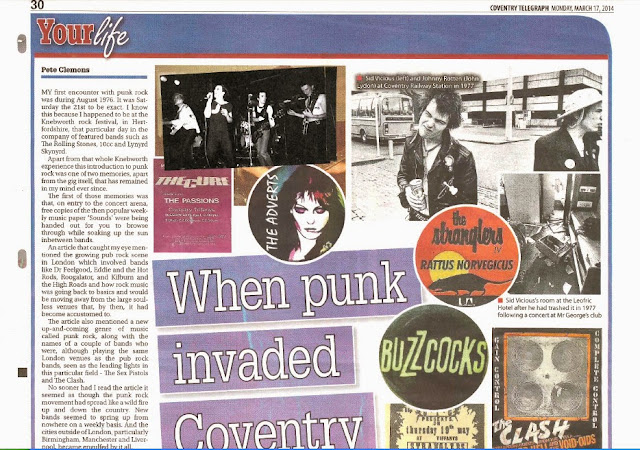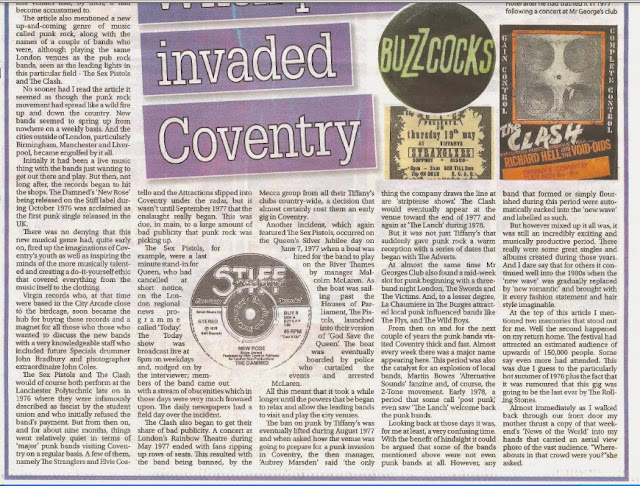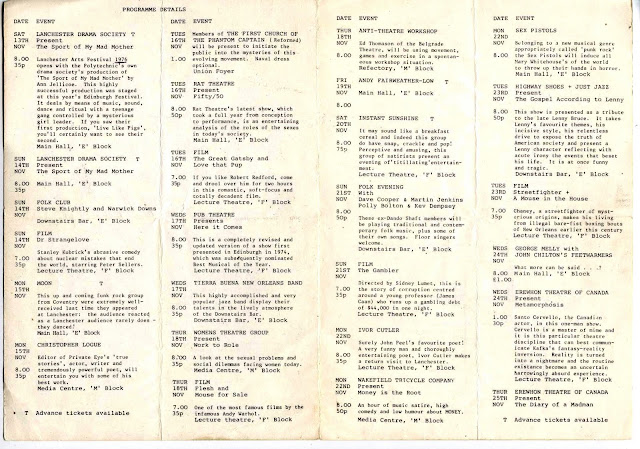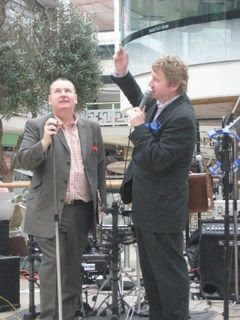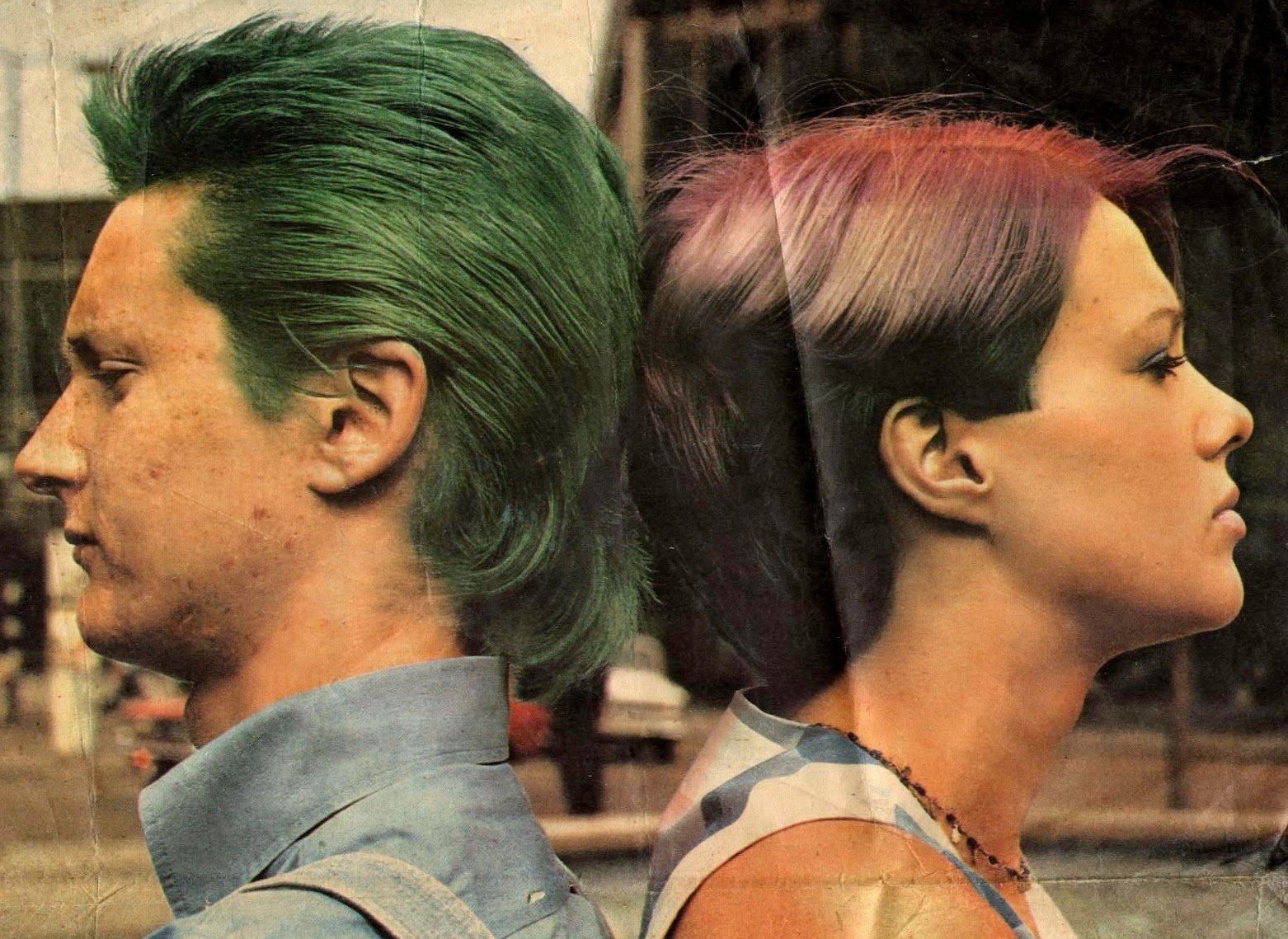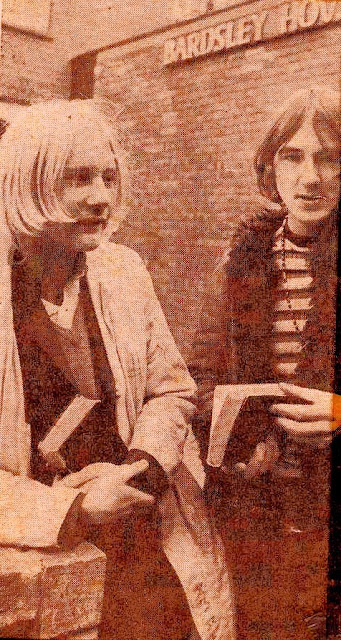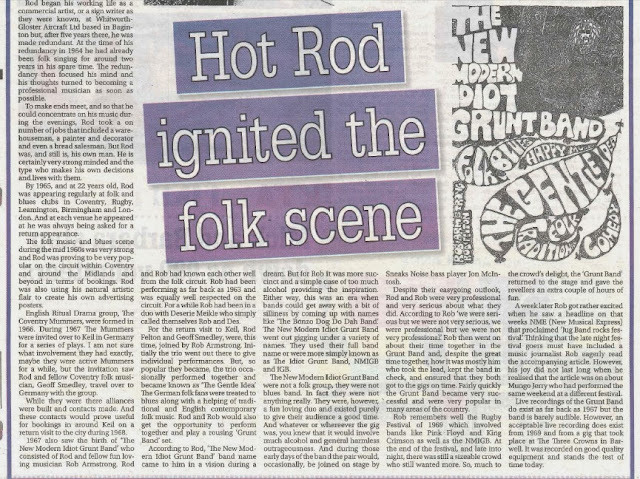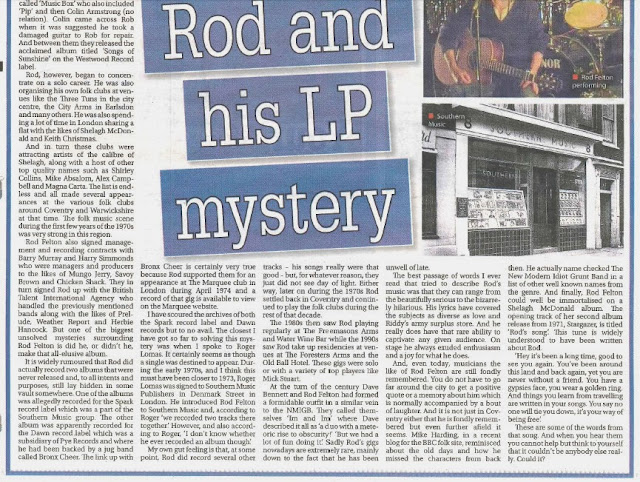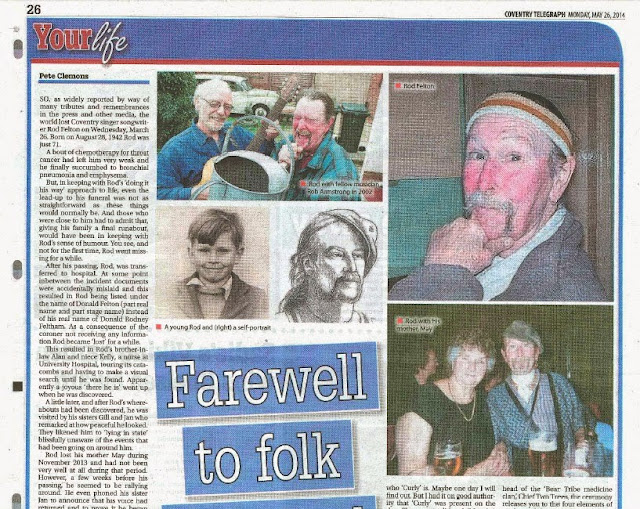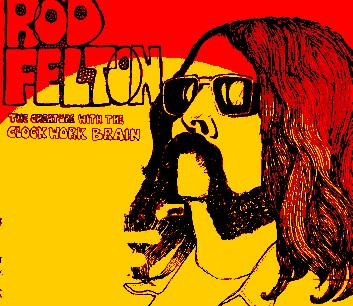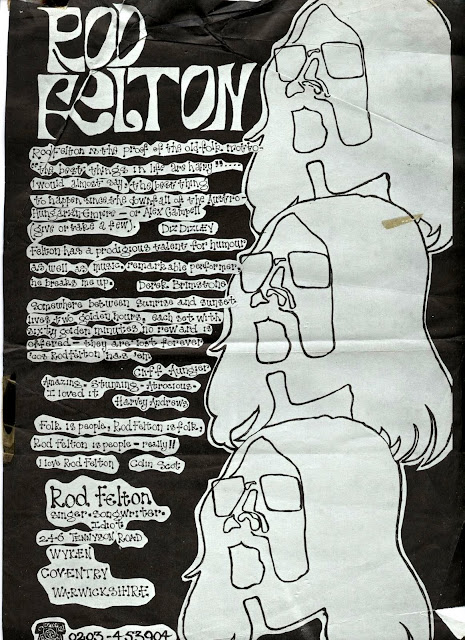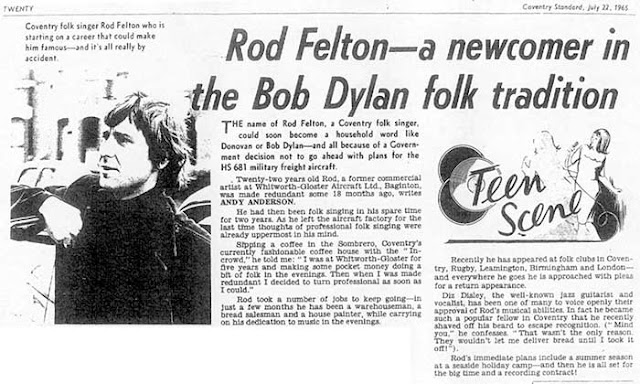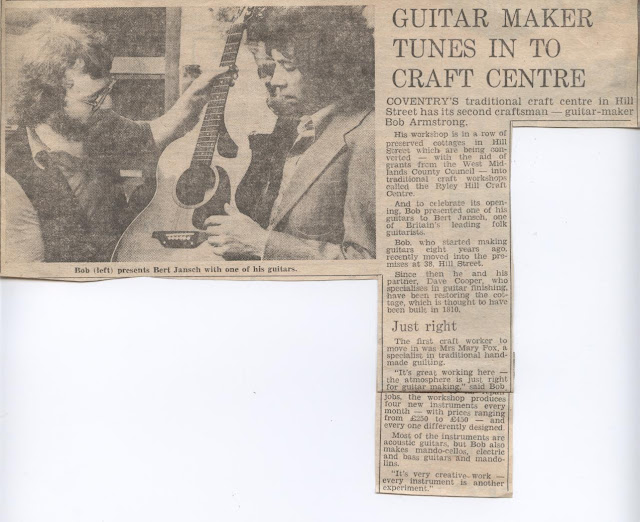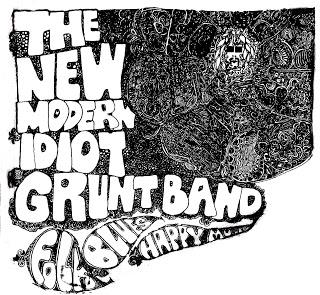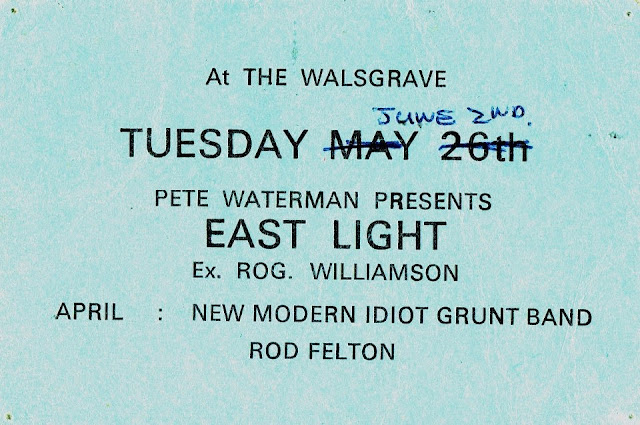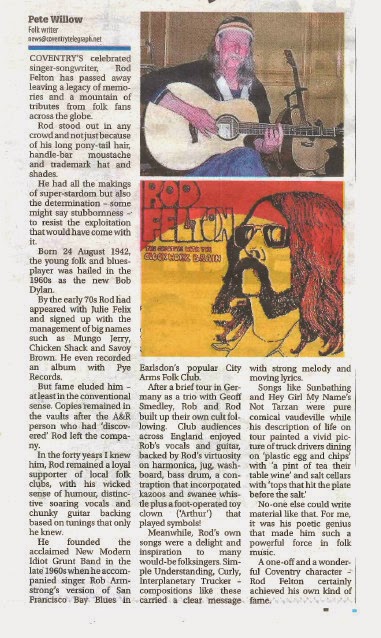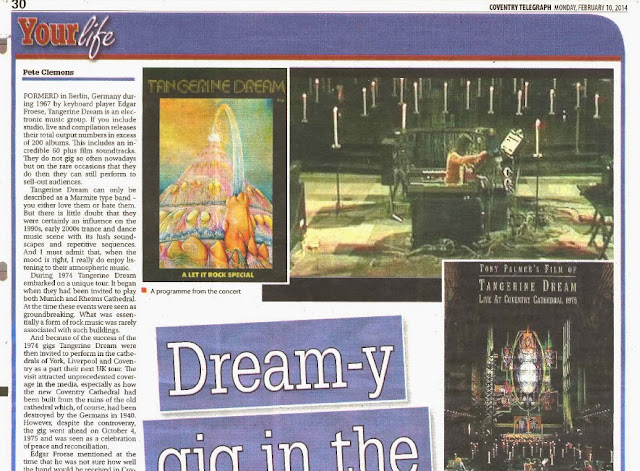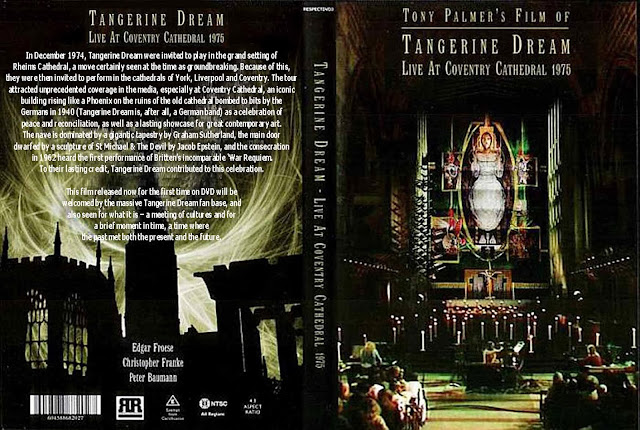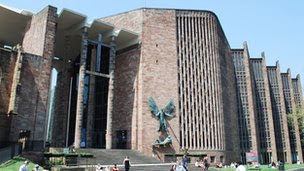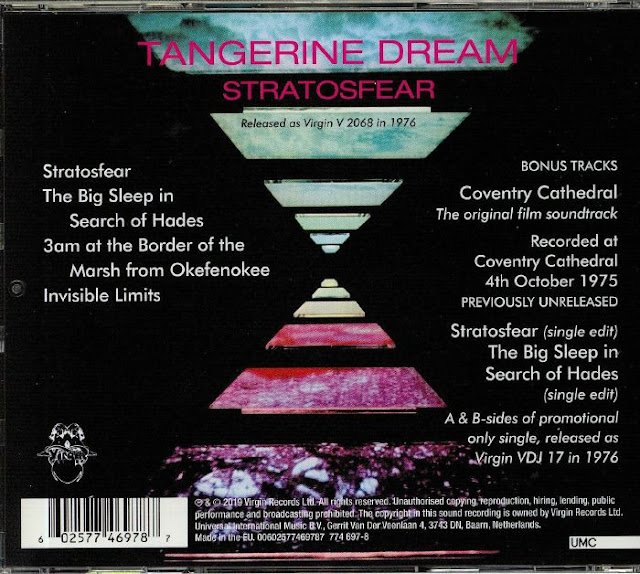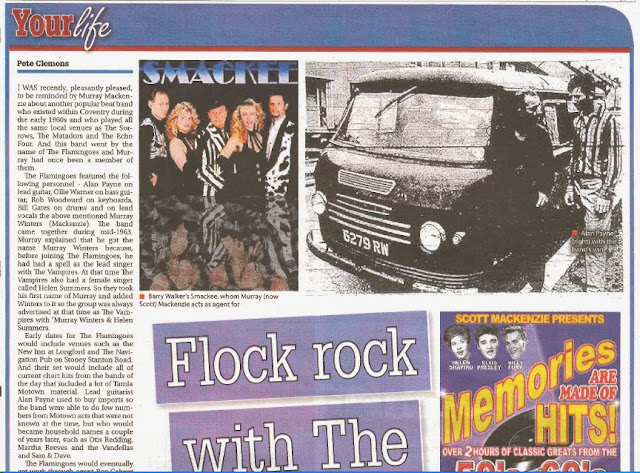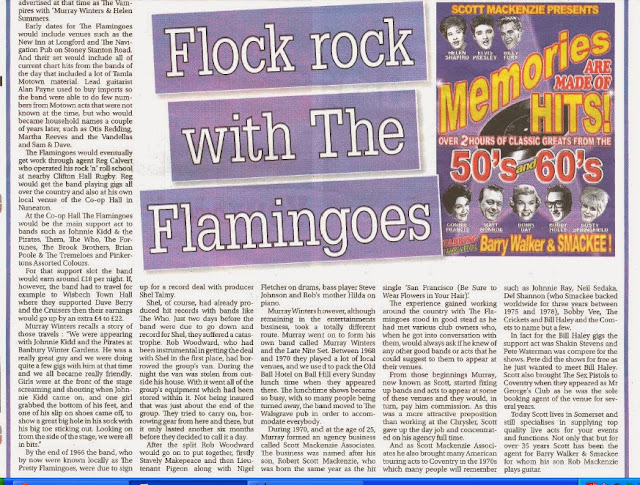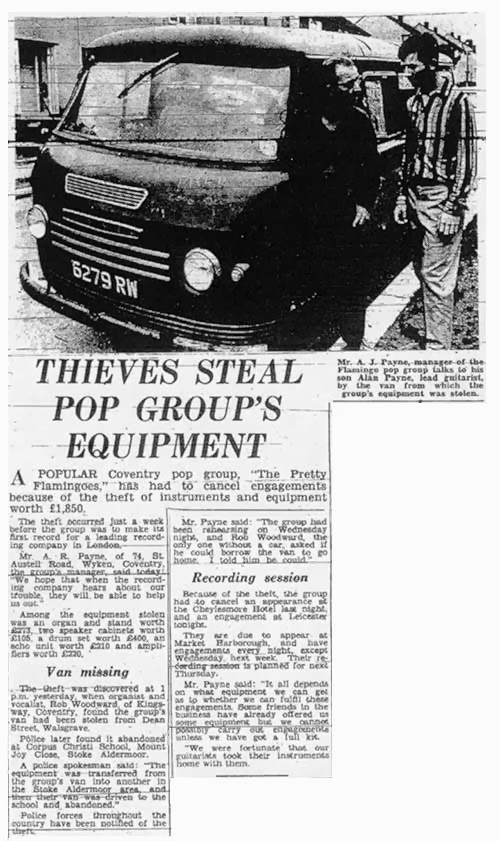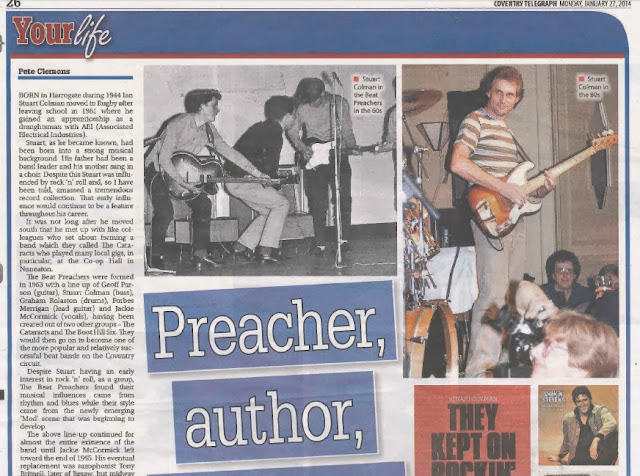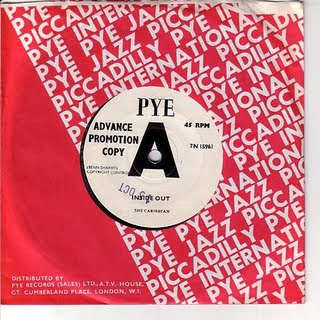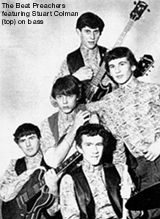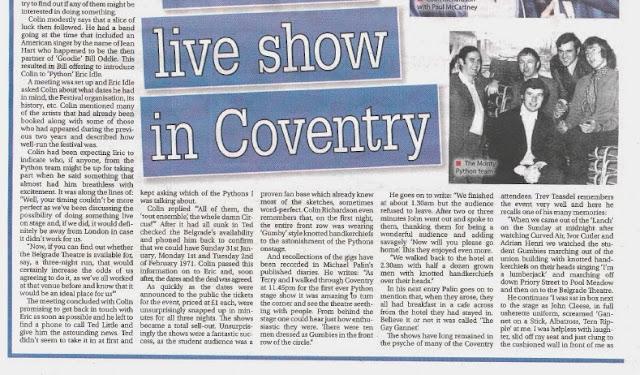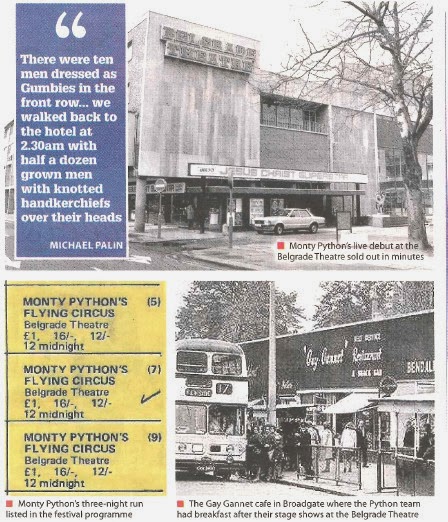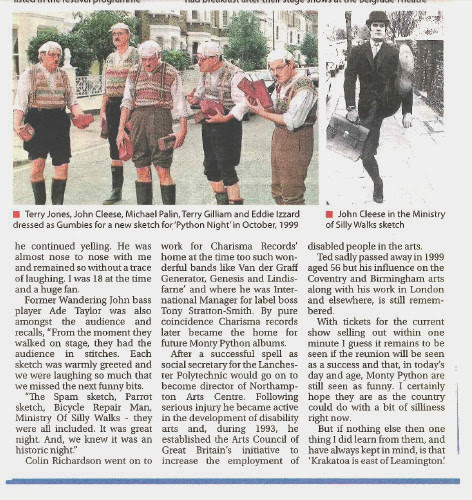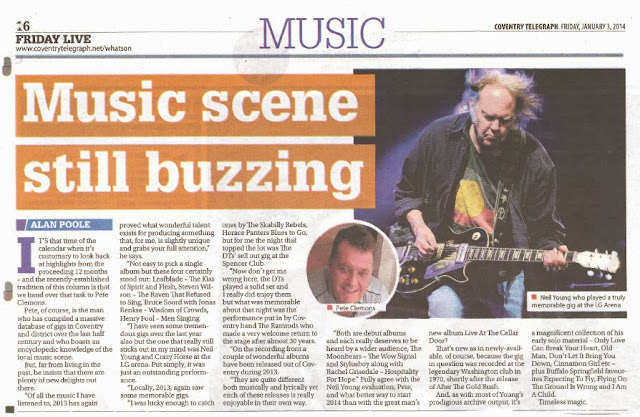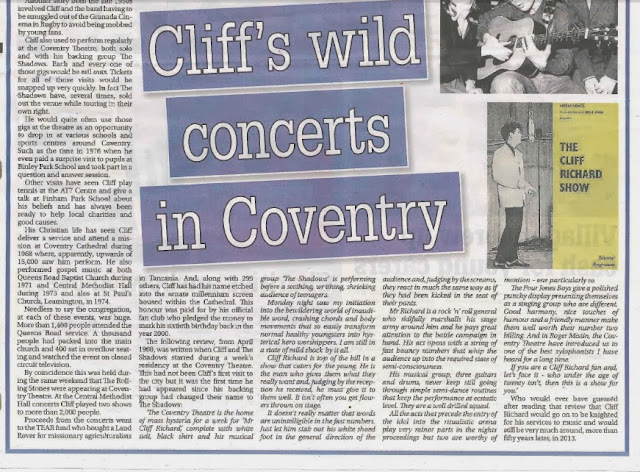The Flamingoes
c 1964-66 Pop/Beat group.
Hard gigging pop/beat outfit.
2017 – NEW additions to this page from Pete Clemons below his original article for Coventry Telegraph
Possible recordings exist from August 1966. Winters was “…booked for 6 weeks of cabaret in Leeds..” in September 1969.”
A while back Murray McKenzie (AKA Murray Winters and Scott McKenzie) got in contact with Hobo. I passed the contact to Pete Clemons who interviewed him about his 60’s band The Flamingoes and his subsequent career as a promoter. Very interesting and the result was published in The Coventry Telegraph recently. Rob Woodward of Lieutenant Pigeon was also in the Flamingoes.
Line up: Alan Payne on lead guitar, Ollie Warner on bass guitar, Rob Woodward on keyboards, Bill Gates on drums and on lead vocals the above mentioned Murray Winters (Mackenzie)
FLOCK ROCK WITH THE FLAMINGOES
BY PETE CLEMONS
For the Coventry Telegraph 2014
I WAS recently, pleasantly pleased, to be reminded by Murray Mackenzie about another popular beat band who existed within Coventry during the early 1960s and who played all the same local venues as The Sorrows, The Matadors and The Echo Four. And this band went by the name of The Flamingoes and Murray had once been a member of them.
The Flamingoes featured the following personnel – Alan Payne on lead guitar, Ollie Warner on bass guitar, Rob Woodward on keyboards, Bill Gates on drums and on lead vocals the above mentioned Murray Winters (Mackenzie). The band came together during mid-1963. Murray explained that he got the name Murray Winters because, before joining The Flamingoes, he had had a spell as the lead singer with The Vampires. At that time The Vampires also had a female singer called Helen Summers. So they took his first name of Murray and added Winters to it so the group was always advertised at that time as The Vampires with ‘Murray Winters & Helen Summers.
Early dates for The Flamingoes would include venues such as the New Inn at Longford and The Navigation Pub on Stoney Stanton Road. And their set would include all of current chart hits from the bands of the day that included a lot of Tamla Motown material. Lead guitarist Alan Payne used to buy imports so the band were able to do few numbers from Motown acts that were not known at the time, but who would became household names a couple of years later, such as Otis Redding, Martha Reeves and the Vandellas and Sam & Dave.
The Flamingoes would eventually get work through agent Reg Calvert who operated his rock ‘n’ roll school at nearby Clifton Hall Rugby. Reg would get the band playing gigs all over the country and also at his own local venue of the Co-op Hall in Nuneaton.
At the Co-op Hall The Flamingoes would be the main support act to bands such as Johnnie Kidd & the Pirates, Them, The Who, The Fortunes, The Brook Brothers, Brian Poole & The Tremeloes and Pinkertons Assorted Colours.
For that support slot the band would earn around PS18 per night. If, however, the band had to travel for example to Wisbech Town Hall where they supported Dave Berry and the Cruisers then their earnings would go up by an extra PS4 to PS22.
Murray Winters recalls a story of those travels : “We were appearing with Johnnie Kidd and the Pirates at Banbury Winter Gardens. He was a really great guy and we were doing quite a few gigs with him at that time and we all became really friendly. Girls were at the front of the stage screaming and shouting when Johnnie Kidd came on, and one girl grabbed the bottom of his feet, and one of his slip on shoes came off, to show a great big hole in his sock with his big toe sticking out. Looking on from the side of the stage, we were all in bits.”
By the end of 1966 the band, who by now were known locally as The Pretty Flamingoes, were due to sign up for a record deal with producer Shel Talmy.
Shel, of course, had already produced hit records with bands like The Who. Just two days before the band were due to go down and record for Shel, they suffered a catastrophe.
Rob Woodward, who had been instrumental in getting the deal with Shel in the first place, had borrowed the group’s van. During the night the van was stolen from outside his house. With it went all of the group’s equipment which had been stored within it. Not being insured that was just about the end of the group. They tried to carry on, borrowing gear from here and there, but it only lasted another six months before they decided to call it a day.
After the split Rob Woodward would go on to put together, firstly Stavely Makepeace and then Lieutenant Pigeon along with Nigel Fletcher on drums, bass player Steve Johnson and Rob’s mother Hilda on piano.
Murray Winters however, although remaining in the entertainments business, took a totally different route. Murray went on to form his own band called Murray Winters and the Late Nite Set. Between 1968 and 1970 they played a lot of local venues, and we used to pack the Old Ball Hotel on Ball Hill every Sunday lunch time when they appeared there. The lunchtime shows became so busy, with so many people being turned away, the band moved to The Walsgrave pub in order to accommodate everybody.
During 1970, and at the age of 25, Murray formed an agency business called Scott Mackenzie Associates. The business was named after his son, Robert Scott Mackenzie, who was born the same year as the hit single ‘San Francisco (Be Sure to Wear Flowers in Your Hair)’.
The experience gained working around the country with The Flamingoes stood in good stead as he had met various club owners who, when he got into conversation with them, would always ask if he knew of any other good bands or acts that he could suggest to them to appear at their venues.
From those beginnings Murray, now known as Scott, started fixing up bands and acts to appear at some of these venues and they would, in turn, pay him commission. As this was a more attractive proposition than working at the Chrysler, Scott gave up the day job and concentrated on his agency full time.
And as Scott Mackenzie Associates he also brought many American touring acts to Coventry in the 1970s which many people will remember such as Johnnie Ray, Neil Sedaka, Del Shannon (who Smackee backed worldwide for three years between 1975 and 1978), Bobby Vee, The Crickets and Bill Haley and the Comets to name but a few.
In fact for the Bill Haley gigs the support act was Shakin Stevens and Pete Waterman was compere for the shows. Pete did the shows for free as he just wanted to meet Bill Haley. Scott also brought The Sex Pistols to Coventry when they appeared as Mr George’s Club as he was the sole booking agent of the venue for several years.
Today Scott lives in Somerset and still specialises in supplying top quality live acts for your events and functions. Not only that but for over 35 years Scott has been the agent for Barry Walker & Smackee for whom his son Rob Mackenzie plays guitar.
END
…………………………………….
The following article is from the Coventry Evening Telegraph, sourced via the Broadgate Gnome site and Paul Connew, later of Daily Mirror, mistakenly referred to them as The Pretty Flamingoes in the article. However the band was called The Flamingoes.
Memories and Comments from Lead Guitarist Alan Payne.
“I was in a local band called “The Flamingoes” which included the best drummer / vocalist I’ve ever heard, a guy called Bill Gates, no not that one! Equally on a par with the likes of Roger Taylor, Keith Moon etc.We had a residency at the Walsgrave on Tuesday nights and every week there would be a local guest band too.
This one week the guest band was one called “Listen” which had a 16 year old Robert Plant and John Bonham which eventually lead to Led Zeppelin. They were both phenomenal even at that age!
There was another Coventry band called “The Beat Preachers” who had another great drummer (can’t remember his name sadly).
If we both played a gig together people would come from miles just to hear an amazing double drum solo from Bill Gates and the other drummer, it was like listening to a duet by Buddy Rich and Gene Krupa – breathtaking!!
When the Flamingoes split I joined a Birmingham duo called: “Double Feature” who had voices like Stevie Winwood and we recorded the first ever version of “Handbags and Gladrags!! We used to do gigs with the likes of Roy Wood, The Moody Blues, Jeff Lynne etc. We were quite well known on the Bham scene at the time.”
………………………………………………………………………
NEW ARTICLE FROM PETE CLEMONS Nov 2017
Bill Gates and the Flamingoes Part 1
I was amazed at how, fairly recently, a random post on Facebook that started with normal chatter developed into a rather touching story that had a cracking ending.
It began with Coventry born bass player, Ade Taylor, linking a Coventry Telegraph article to his wall. The article, which was about The Walsgrave pub, contained a picture of a Coventry band that Ade was a member of called Wandering John. And Ade’s accompanying comment was ‘The Coventry scene back in the day. Me top left, far left’.
Additional comments to Ade’s original post widened the conversation around the local music scene during the 1960s and 1970s.
Then one of Ade’s FB friends – another Coventry born musician, Alan Payne, responded with this comment ‘Talking about the Walsgrave, that was a pub near me, I lived in Wyken. I was in a local band called “The Flamingoes” which included the best drummer/vocalist I’ve ever heard, a guy called Bill Gates, no not that one! Equally on a par with the likes of Roger Taylor, Keith Moon etc. We had a residency at the Walsgrave on Tuesday nights and every week there would be a local guest band too. This one week the guest band was one called “Listen” which had a 16 year old Robert Plant and John Bonham which eventually lead to Led Zeppelin. They were both phenomenal even at that age!’
The conversation continued……………..
Ade Taylor: ‘Great story Alan, from great times. I bet your band weren’t half bad either!’
Alan Payne: ‘They were mate, we used to do gigs with the likes of Roy Wood, The Moody Blues, Jeff Lynne etc. We were quite well known on the Birmingham scene at the time. It was those days that made me the musician I am now’.
Then I joined in the conversation by posting a different article up which was more specific to The Flamingoes.
Alan Payne: ‘Thanks Pete, I’m amazed!. Even more so cos that’s the only photo now have of my dad!’
Even Roger Lomas joined in the chatter: ‘Good ol’ Arthur’
To which Alan Payne replied: ‘I’m stunned you even remember my Dad, he sure was one of the world’s larger than life figures and oh that laugh!!’
Roger Lomas: ‘Remember him well Alan’
Alan Payne: ‘Oh I do Roger, EVERYDAY, it’s good to know he’s not forgotten
Alan Payne: ‘And a great thank you to you Ade, had you not done your posting about The Walsgrave pub I would never found the picture of my dad and the info on Google about my band!’
What a fantastic conversation to read and to have gotten involved with. And it didn’t end there………..
Part 2 – Bill Gates
After I wrote my article about The Flamingoes, I remember I had a lovely chat with a lady called Gill who had been the partner of Flamingoes drummer Bill Gates, who Alan had praised so highly in the earlier conversation. Gill had read the article and added more meat to the bone about the band and Bill Gate’s musical activities.
I clearly remember Gill mentioning the fact that Bill had had a brush with The Beatles. And that meeting could have changed the whole Beatles history. But it was that huge a comment that I admit to brushing it under the carpet. It was not that I didn’t believe Gill, it was more a case she had embellished the story.
But while chatting to Alan Payne off line, he mentioned the very same story at which I immediately felt remorse towards Gill for ever doubting her. Not only that, but Alan revealed some more startling facts. I have penned a brief resume of our chat below………………
Alan: ‘Did you know that Bill met Gill while in Spain?. She was doing film extra work there and did the horse riding scenes for Sophia Loren in El Cid. She had beautiful dark hair like Sophia’
Alan: ‘The strange thing was that many years later I had dinner with Sophia Loren and Carlo Ponti at Thames Television Studios in Teddington where I worked and Sophia remembered all about it’.
Me: I mentioned to Alan that I never realised any of that but what I did remember was that Gill clearly missed her Bill who had passed away during 1993.
Alan: ‘I do too!. Nearly everything I know about music and life itself came from him. Like my Dad he was a larger than life character and extremely talented. Whilst doing his national service in Germany he played drums a few times with The Beatles. Apparently Paul McCartney wanted him for the band because of his great vocals but he couldn’t get out of his national service. He had some acetates of their time together in Germany. Can’t imagine what they’d be worth if they had survived. Also, Bill’s mother was my music teacher at King Henry VIII school. Bill should have been a huge star!’
It was at this point I admitted to Alan that Gill had mentioned the Beatles connection and that I had just nodded my head, not taking it too seriously.
Alan signed off with the following throw away comment. ‘You might also like to know that not long after moving to London in 1980 I became close friends with Freddie Mercury till his death’.
To complete the story, here are some final pieces of information, from notes I made at the time I was talking to Gill……….
When The Flamingoes infamously had their van was stolen towards the end of 1966, amongst other items, Bill lost his drum kit. It was a Slingerland and was only one of seven in the country at that time. He replaced it with a Ludwig kit.
Bill would practise his drumming every day, to records by gene Krupa and Buddy Rich.
Bill’s brush with The Beatles came, as mentioned, when he was stationed in Germany. The Beatles, at that time, were playing in Hamburg while Bill was stationed in Monchengladbach with The Royal Signals.
Pete Best was The Beatles drummer between August 1960 and August 1962. And it seems that Bill stepped in for Pete Best, in Germany, on more than one occasion. Of course it has been well documented how Pete was eventually replaced by Ringo Starr.
But it now appears that the course of Beatles history could have taken a completely different path had the rest of the band been agreeable and Bill Gates had been able to join them. Makes you wonder doesn’t it.

Alan Payne with Freddie Mercury – they were close friends

